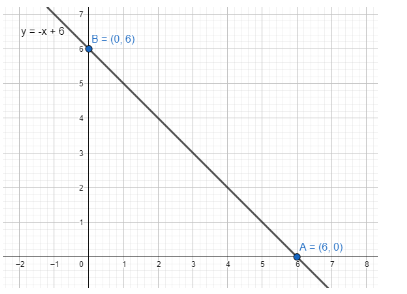
How do you graph $y=-x+6$?
Answer
443.1k+ views
Hint:Change of form of the given equation will give the x-intercept and y-intercept of the line $y=- x+6$. We change it to the form of $\dfrac{x}{p}+\dfrac{y}{q}=1$ to find the x intercept, and y intercept of the line as $p$ and $q$ respectively. then we place the points on the axes and from there we draw the line on the graph.
Complete step by step solution:
We are taking the general equation of line to understand the slope and the intercept form of the line $y=-x+6$. The given equation is in the form of $y=mx+k$. m is the slope of the line. The slope of the line is $-1$.
We have to find the x-intercept, and y-intercept of the line $y=-x+6$.
For this we convert the given equation into the form of $\dfrac{x}{p}+\dfrac{y}{q}=1$. From the form we get that the x intercept, and y intercept of the line will be$p$ and $q$ respectively. The points will be $\left( p,0 \right),\left( 0,q \right)$.
The given equation is $y=-x+6$. Converting into the form of $\dfrac{x}{p}+\dfrac{y}{q}=1$, we get
$\begin{align}
& y=-x+6 \\
& \Rightarrow x+y=6 \\
& \Rightarrow \dfrac{x}{6}+\dfrac{y}{6}=1 \\
\end{align}$
Therefore, the x intercept, and y intercept of the line $y=5x-3$ is 6 and 6 respectively. The axes intersecting points are $\left( 6,0 \right),\left( 0,6 \right)$.

Note: A line parallel to the X-axis does not intersect the X-axis at any finite distance. Hence, we cannot get any finite x-intercept of such a line. Same goes for lines parallel to the Y-axis. In case of slope of a line the range of the slope is 0 to $\infty$
Complete step by step solution:
We are taking the general equation of line to understand the slope and the intercept form of the line $y=-x+6$. The given equation is in the form of $y=mx+k$. m is the slope of the line. The slope of the line is $-1$.
We have to find the x-intercept, and y-intercept of the line $y=-x+6$.
For this we convert the given equation into the form of $\dfrac{x}{p}+\dfrac{y}{q}=1$. From the form we get that the x intercept, and y intercept of the line will be$p$ and $q$ respectively. The points will be $\left( p,0 \right),\left( 0,q \right)$.
The given equation is $y=-x+6$. Converting into the form of $\dfrac{x}{p}+\dfrac{y}{q}=1$, we get
$\begin{align}
& y=-x+6 \\
& \Rightarrow x+y=6 \\
& \Rightarrow \dfrac{x}{6}+\dfrac{y}{6}=1 \\
\end{align}$
Therefore, the x intercept, and y intercept of the line $y=5x-3$ is 6 and 6 respectively. The axes intersecting points are $\left( 6,0 \right),\left( 0,6 \right)$.

Note: A line parallel to the X-axis does not intersect the X-axis at any finite distance. Hence, we cannot get any finite x-intercept of such a line. Same goes for lines parallel to the Y-axis. In case of slope of a line the range of the slope is 0 to $\infty$
Recently Updated Pages
Master Class 11 Accountancy: Engaging Questions & Answers for Success

Glucose when reduced with HI and red Phosphorus gives class 11 chemistry CBSE

The highest possible oxidation states of Uranium and class 11 chemistry CBSE

Find the value of x if the mode of the following data class 11 maths CBSE

Which of the following can be used in the Friedel Crafts class 11 chemistry CBSE

A sphere of mass 40 kg is attracted by a second sphere class 11 physics CBSE

Trending doubts
Define least count of vernier callipers How do you class 11 physics CBSE

The combining capacity of an element is known as i class 11 chemistry CBSE

Proton was discovered by A Thomson B Rutherford C Chadwick class 11 chemistry CBSE

Find the image of the point 38 about the line x+3y class 11 maths CBSE

Can anyone list 10 advantages and disadvantages of friction

Distinguish between Mitosis and Meiosis class 11 biology CBSE




